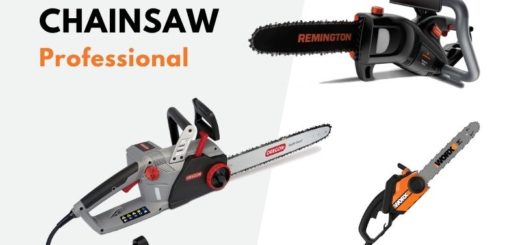5 Best Gas-Powered Chainsaws
A chainsaw is an indispensable power tool that can effortlessly cut through bushes, fall a roof-threatening tree, slice off dangerous broken tree limbs, dice stumps into firewood, and build fences. Once limited exclusively to farmers and lumberjacks, Chainsaws have gained immense popularity and are today available in a sheer variety of types and sizes and are used by homeowners, arborists, gardeners, landscapers, loggers, firefighters, carpenters, chainsaw artists, etc.
Professional Chainsaws
Professional-grade chainsaws have the reliability, power, and features to tackle the most challenging jobs, including logging, farming, land clearing, tree service, and firewood cutting. These chain saws are equipped with bar lengths greater than 20 inches making them suitable for medium and large trees and storm cleanup and cutting firewood.
Professional gas chainsaws are ergonomically designed, lightweight, balanced, and boast features such as vibration dampening systems, larger fuel tanks, higher RPM engines, and top handles that deliver additional firepower to tackle heavy-duty jobs but remain comfortable to use for a long duration.
Chainsaw Power Source
Chainsaws are primarily powered by gasoline, electricity, or batteries. Gas-powered chainsaws are among the most robust chainsaws available in the market. Their quicker chain speed requires less force from the operator to produce clean cuts and offers extra torque, making them ideal for heavy-duty work.
Gas-powered chainsaw’s power and portability come incredibly handy when cutting logs and trees in forested areas or remote places. A typical gas-powered saw has bars reaching up to 60 inches, giving them incredible cutting capacity and depth. Gas chainsaws range from light-duty models to professional-grade saws and are made for every kind of user, from the first-time homeowner to the seasoned logging pro.
Gasoline-powered chainsaw work on a pull-start mechanism and primarily come with a 2-cycle engine. Two-stroke engines need the oil to be mixed directly with the fuel in a specific ratio as recommended by the manufacturer. You can also buy premixed oil off the shelf, sparing you the hassle of creating your own fuel mixture, but it’s more expensive.
Gas-powered chainsaws are noisier, heavier, and require periodic maintenance of fuel filters and spark plugs. Gas-powered engines emit harmful toxins such as carbon monoxide.
Things to Consider Before Buying a Chainsaw
Before investing in a gas-powered chainsaw, consider the scope of work. Chainsaws vary drastically in size, shape, features, styles, and capabilities; hence ensure to consider your requirements for mobility, ease of starting, weight, size, and type of woodcutting, experience, and initial and running costs.
Chainsaw Size: Chainsaw power is measured by piston displacement (cc) and engine power (HP). If your job requires felling trees or cutting into hardwood, choose a larger chainsaw with more power. Using a smaller saw for larger jobs will increase inefficiency and unnecessary physical exertion and damage the product.
Weight: Larger bars with bigger motors tend to be heavier, challenging to maneuver, create more vibration, and potentially hazardous— something to consider if you need to use the saw for extended periods. A smaller, less powerful saw will be more manageable, particularly if you don’t have much experience. These heavy-duty machines typically weigh from 10 to 25 lbs before fueling; hence you need to consider the weight of the chainsaw you can comfortably hold without getting fatigued, especially if you have a heavy workload.
Guide Bar Length: Guide Bar length represents the active cutting area and denotes the largest wood length you can cut in a single pass. Measured from the chain’s tip to where it enters the housing, it increases in increments of 2 inches. The rule of thumb is to use a chainsaw bar length that’s 2 inches longer than the thickness of the object you need to cut, giving you enough clearance at the tip of the chain for a safer cut.
If you need to cut a 12″ tree in one pass, then a 14″ or bigger would be enough. You can use two passes to cut a larger tree with a small chainsaw; for example, two passes of a 16″ bar length will cut a 32-inch tree; however, if you need to have a more comprehensive cut regularly, then a smaller bar length will be the wrong choice.
Oiler Type: It is essential to regularly lubricate the chainsaw bar and blade to prevent the machine from getting overheated and worn. Oilers come in three types: manual and two automatic versions.
Manual Oiling – You need to manually oil the bar and chain. Manual oiling requires constant attention but gives you control over the lubrication and timing, making it suitable for people who want precise control over the oiling process.
Automatic Oiling (Fixed Flow) – In this mechanism, the chainsaw will automatically lubricate the blade and chain at a fixed rate of flow, without any hassle. However, the user cannot adjust the flow.
Automatic Oiling (Adjustable Flow) – This process combines the best feature of manual and automatic oiling and provides constant lubrication but allows you to tweak the flow rate according to the requirement.
Handle Position: Chainsaws come with rear and top handles. Top-handle saws are compact and lighter and can often be used one-handed. But they are designed for use at height, which sacrifices stability. If you’ll be taking down trees or working with large logs on the ground, it’s probably wiser to choose a rear-handle model with a broader handgrip for more protection against kickback.
Chainsaw Features
Anti-Vibration System: Some chain saw features a mechanism that separates the chainsaw rear handle from having contact with the engine. This dampens vibration and lowers operator fatigue allowing you to work longer while minimizing any potential discomfort.
Chain Brake: This safety mechanism helps prevent the blade from spinning back during kickback (a sudden thrust or force towards the operator when the blade hits something hard or gets pinched between tree fibers). When kickback occurs, the chain brake bar instantly stops the chain motion almost immediately. Chain brakes are available in two types – Manual and inertia-activated.
Manual Chain Brake: The chain will stop spinning when any physical contact happens with the wide bar. Manual chain brakes work when they’re pushed forward by your hand or arm during the kickback.
Inertia-Activated Chain Brake: This is a sophisticated version of a chain brake activated by the force of inertia. It doesn’t require any physical contact to stop the chainsaw from working.
Spring Assist Start: A spring-assist starting feature reduces the pull force required for starting the saw.
Visible Bar-Oil Gauge: This feature consists of a transparent tank or viewing strip that creates the ability to check bar and chain oil levels at any time.
Air-Cleaning Filter: It avoids any accumulation of dirt, debris, and sawdust in the chainsaw’s internal parts. It extends air filter life by removing large pieces of debris before they reach the filter.
Bucking Spikes: These are metal spikes on the front of a chainsaw at the bar’s base. They allow more controlled sawing by jabbing the spikes into the tree trunk or log so you can pivot the saw blade downward for a clean-cut; it also acts as a safety feature to grip onto a log or tree trunk in the event of kickback to prevent injury.
Side-Mounted Chain Tensioning: This mechanism allows you to quickly adjust the chainsaw chain’s tightness while working. Most versions are tool-less designs where you can easily adjust the chain tension without using a special tool.
Chain Catcher: A chain catcher consists of a metal extension underneath the guide bar that prevents a thrown chain from flying back and hitting the user.
Spring Assist: It decreases the pulling force that is required while starting a gas-powered saw.
Muffler: The muffler reduces chainsaw noise. Many mufflers come with a spark arrestor screen to prevent sparks from escaping.
Chainsaw Case: A chainsaw case, sheath, or cover, provides convenience in transporting and prevents potential injury when carrying the saw and could also help contain oil leaks from the chain.
Heated Carburetor: A heater carburetor enables you to operate your chainsaw in harsh winter conditions by preventing your chainsaw from freezing.
Secondary rear handles give you more maneuverability and leverage when cutting logs on the ground by letting you do a double overhand grip on the saw.
Chainsaw Safety
Chainsaws are dangerous if not used properly. According to the U.S. Consumer Product Safety Commission, there are over 27,000 chainsaw injuries every year in the United States, ranging from lacerations, particularly to the arms and legs, to severe accidents when the saw’s chain snags and kicks back toward the operator’s chest and head. It is vital to ensure the particular model’s quality and safety features to buy.
The most important thing you can do for your safety is read the instructions in full before using them.
Dress Smart:
Invest in protective gear to wear each time you use it to keep yourself safe.
Buy a head protection system that combines a hard hat, hearing protection, and a visor for eye protection to protect your head against falling branches and flying splinters.
Use snug-fitting clothing and sturdy work boots, preferably steel-toed.
A chainsaw is a relatively noisy tool; at full tilt, gas-powered models can exceed 100 decibels, which can impair your hearing. Ensure to wear noise-canceling headphones or earplugs to limit damage related to noise. Always wear gloves, protective footwear, and a visor or safety goggles!
Best Gas Powered Chainsaws With Reviews:
1. Craftsman CMXGSAMY426S 46cc 2-Cycle Full Crank 20-Inch Gas Powered Chainsaw with Carrying Case
The Craftsman S205 gas-powered chainsaw features a 46cc full-crank high output engine that delivers reliable power. The pro-grade chassis is engineered to withstand brutal and prolonged cutting tasks, including tree de-limbing, pruning, cutting, and trimming. The 20″ low kickback bar and chain, bucking spikes, and inertia-activated chain brake provides greater control and goes through even the most challenging wood effectively and easily.
The Craftsman S205 gas-powered chainsaw is equipped with Easy Start technology for simpler and efficient pull starts. The chainsaw features cushioned full wrap aluminum handle and a 5-point anti-vibration system, making the equipment balanced, maneuverable, and comfortable to operate. It includes an adjustable automatic oiler that helps keep the bar and chain in quality condition to perform optimally.
The Craftsman S205 gas-powered chainsaw boasts features such as an inertia-activated chain brake and tool-free access to filter, while the spark plug enhances the chainsaw’s design to make cutting a breeze.
The pro-grade chainsaw comes with a heavy-duty carrying case for easy storage and transport and 2-cycle oil for added convenience. This Craftsman chainsaw is battle-tested for the most demanding yard work tasks and is backed by a 2-year limited warranty.
Pros
- Well-built
- Powerful and heavy-duty
- Low vibrations
- Easy pull start
- Automatic oiling
- Easily accessible Air filter
- The spark plug is covered
- Carry case included
Cons
- Can feel heavy at 25 lbs (without fuel)
2. Echo CS-590-24 59.8cc 24″ Rear Handle Timber Wolf Chainsaw
The Echo CS-590 Timber Wolf is a lightweight professional-grade chainsaw. It features a 59.8cc professional-grade, 2-stroke engine for outstanding performance that effectively handles farm and ranch category jobs. This engine can efficiently handle bars up to 24 inches, and at only 13.2 lbs dry, it boasts a lightweight but durable construction.
The Echo CS-590 Timber Wolf comes with an automatic, adjustable clutch-driven oiler for reduced oil consumption. It comes with a decompression valve for easier start rope pulling and includes easy-access, heavy-duty two-piece air filters for stress-free cleaning. This machine has a fuel tank with a respectable .57 liter capacity that holds enough fuel to get you through hours of work.
The Echo CS-590 Timber Wolf features G-Force Engine Air Pre-Cleaner™ for reduced filter maintenance and comes with a translucent fuel tank for quick fuel level checks. The pro-grade chainsaw also boasts features such as a spring anti-vibration system, side-access chain tensioner, clutch-driven oiler, and dual-post chain brake system to make your job easier. The Timber Wolf is backed by a five-year consumer warranty or a one-year commercial warranty.
Pros
- Vibration dampening
- Excellent balance and smooth cuts
- Easy to start
- Very powerful motor
- Cons
- Guard may crack easily
3. Husqvarna 562XP at Chainsaw, 3/8″ Pitch.058″ Gauge
The Husqvarna 562 XP® was developed for professional loggers and skilled landowners. The all-around chainsaw features a groundbreaking design and is loaded with innovative solutions including a large-surface air filter and AutoTune™, ensures a stable operation and accurate tuning,
The Husqvarna 562 XP features X-Torq® engine technology that provides more power where you need it, with up to 20% less fuel consumption and 60% fewer exhaust emissions. It also makes the saw CARB compliant. It also includes RevBoost™ that delivers instantly high acceleration in chain speeds for extra efficiency during cutting, especially de-limbing work. RevBoost is controlled by the ignition and enables users to increase to maximum RPMs for about two seconds quicker. It is designed to provide an optimum power ratio to RPMs without having the engine run wide open for extended periods.
Husqvarna’s revolutionary reduced gyro force technology reduces the weight of the saws’ essential moving parts – flywheel, crankshaft, and piston. Additionally, Husqvarna’s LowVib technology reduces variations caused by the machine. The machine comes with Flip-up tank caps that are easy to open and close when refueling and combined choke/stop control, allowing for easier starting and reducing the risk of engine flooding. It also comes with distinct, colored marks on the chainsaw body used for aiming the direction of tree fall.
The Husqvarna 562 XP’s front handle and handguard are offset by 7 degrees to provide a more natural holding position so you can work longer without harming your arms and hands.
The chainsaw is easy and convenient to handle in any situation thanks to its low and slender body. The package includes HT-380 Pro RSN Chainsaw Guide Bar, 3/8″ pitch, .050 gauge, and large mount.
X-CUT C83 Chainsaw Chain Full chisel, 3/8″ pitch, .050 gauge
Pros
- Fast acceleration
- AutoTune
- Smart Start
- Vibration dampening system
Cons
4. Remington RM4618 Outlaw 46cc 2-Cycle 18-Inch Gas Powered Chainsaw with Carrying Case
The Remington Outlaw is engineered to withstand the most brutal and prolonged cutting tasks. The RM4618 gas-powered chainsaw features a 46cc full crank 2-cycle engine and first-rate 18-inch bar and low-kickback chain that delivers all-around superior performance. The 46cc high output engine comes with a professional-grade chrome bore cylinder that extends engine life and increases durability. The premium 18-inch bar and chain are capable of power through the most challenging wood quickly and easily.
The Remington Outlaw’s robust side-access tensioning system ensures chain tension stays consistent for longer periods – perfect for extended jobs like storm clean-up. The RM4618 gas-powered chainsaw features die-cast chassis and pro-grade components that enhance durability to withstand the most brutal and prolonged cutting tasks, while isolated, cushioned handles reduce vibration makes this chainsaw more balanced, maneuverable, and maintain optimal comfortability and command during operation.
The Remington Outlaw’s reliable engine is equipped with QuickStart technology. It is designed for quicker, smoother, and easier pull starts allowing you to get to work right away on yard work, lawn care, and other projects. It also includes a 5-point anti-vibration system for comfortable operations. The adjustable automatic oiler keeps the chain in quality condition to ensure the saw cuts smoothly and safely.
Pros
- Equipped with an 18-inch bar and chain
- QuickStart technology to make pull starts easier
- 5-point anti-vibration system
- Cushion wrap handle
- Side-access chain tensioner
- Automatic oiler
- Tool-free access for easy maintenance
- Backed by a 2-year limited warranty
Cons
- Some users have complained about vapor lock after every use
- Need to adjust chain frequently
KGK 2 Stroke Gas Power Chain for Cutting Trees, Power Chain Saws with 2 Chains, Tool Kit
The KGK gas-powered chainsaw features a powerful 58 cc 2-cycle engine that delivers steady power to the 20-inch bar low-kickback chain and reduces fuel consumption up to 20%. The 3KW power motor offers consistent performance; the engine speed can reach up to 8500rpm/min, allowing you to maintain strong power when cutting any trees, while the 20-Inch Bar comes with a cutting diameter of 27-33inch that can meet most of the work demand.
The KGK gas-powered chainsaw is ergonomically designed and paired with a comfortable slide-free handle, effectively reducing machine shake to provide a balanced, maneuverable, and comfortable operation. The machine is easy to install, while the spring-assist pull cord combined with an easy-to-use knob ensures that this fast, simple start system is easier to rev up and get right to cutting. It also features a valve throttle protection switch that prevents accidental starts and ensures user safety.
The KGK gas-powered chainsaw features a high-quality chassis and comes with a new ABS plastic surface that can bear high temperature, ideal for all cutting works in farm, garden, ranch, and reduces wear. The high-quality imported steel chains have good wear resistance and can last up to five times longer than ordinary chains. The heavy-duty chainsaw features guide plate sets that prevent the chain from rust and prevent accidental cuts when not using.
Pros
- Low Fuel Consumption
- Breaking system works excellent
- Ergonomic Design
- Easy to assemble and use
- Imported Steel Chains
Cons
- Expensive
Chainsaw Maintenance and Repair Considerations
Chainsaws are heavy-duty monsters; given that they come in contact with all sorts of dirt, debris, wet wood, and thick trees, regular maintenance is essential to keep them running for as long as you need it.
Make sure you are using proper gas and oil fuel mixture ratios and that you are using bar and chain oil to ensure the engine runs properly and smoothly. After each use, be sure to clean your saw of the dirt and sawdust that will accumulate, and stick to the oil ports, guide bar grooves, and even around the power sprocket (easily accessible under the cover).
Sharpening the Chain: A sharp cutting blade reduces the chances of slips and kickback, hence ensure to sharpen the chain regularly based upon the frequency and nature of use. You can sharpen the blade manually or with a rotary tool. Check the chain’s sharpness as dulled edges will work less efficiently and place the strain on the motor as it has to run longer to get the job done. Also, always check for bad links, wear, and damage.
Cleaning – after each use, remove any debris such as sawdust or dirt from the saw. Follow cleaning instructions thoroughly to clean individual parts to avoid damage and rust.
Air Filter – check this after each use, clean it with soapy water or replace it as required.
Carburetor – Clean the carburetor after each use by spraying it with either a fuel additive or compressed air to keep it running smoothly, allowing you to start the engine easily.
Chainsaw Tension: When using a chainsaw for long periods, the chain’s tension must be checked regularly. If the chain is too tight, then the blade may not rotate at its actual speed, and if it is too loose, it breaks or falls off while operating the machine.
Lubricate the chain sprocket at the top of the guide and check for burrs that could cause the chain to jump.
Refer to the owner’s manual – each model has its characteristics and therefore may have specific recommended maintenance.
Emissions: Gas-powered models emit carbon monoxide and other pollutants. All gasoline-powered tools produce carbon monoxide, a colorless, odorless gas that’s potentially fatal. Never run a gasoline-powered tool indoors or in an enclosed space.
Clear the air filter and tune up the engine regularly. During the prolonged absence or the off-season, run the engine until there’s no gas, clean and oil the whole tool, and store the device in a cool and dry place. If a chainsaw sits idle for a long time with gas inside, sludge will jam fuel, carburetor and reduce the performance.










Recent Comments